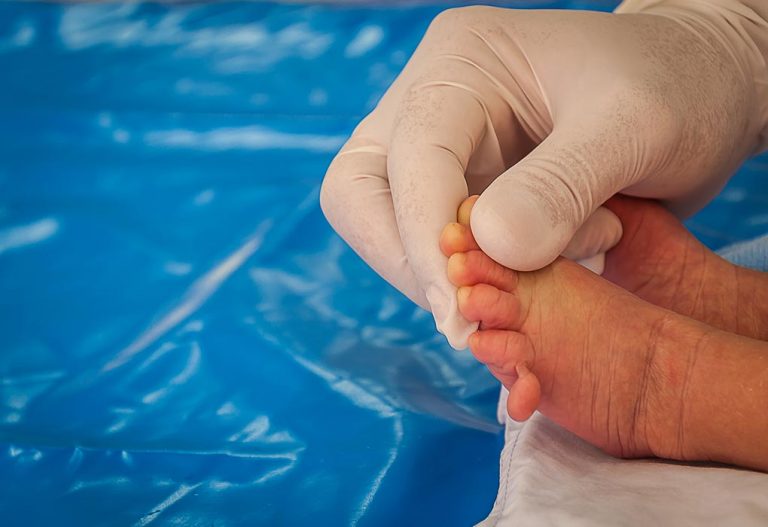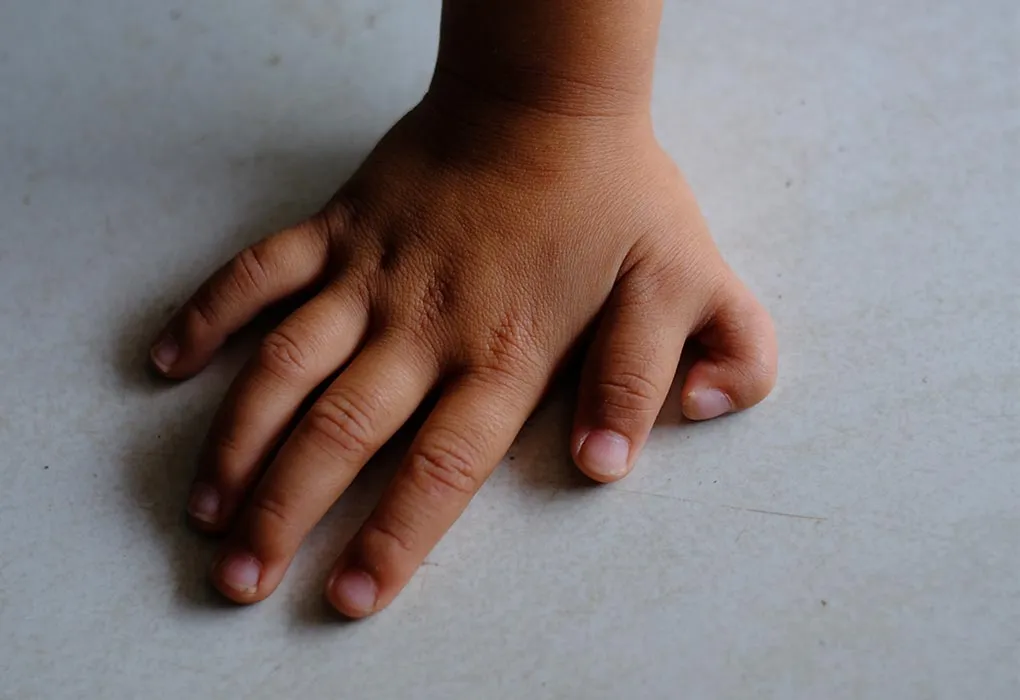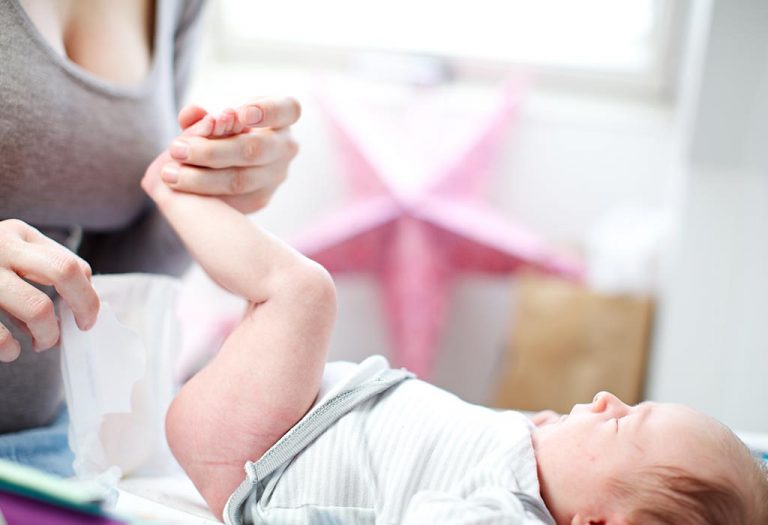Polydactyly (Born With Extra Fingers and Toes) – Causes & Treatments

Ever seen people eager to count their baby’s toes and fingers after birth? Well, don’t be surprised if you notice your mom, husband, or an elder in the family doing the same to check if all twenty of them are intact. But sometimes, to your dismay, there may be an extra toe or finger on your baby—a condition known as polydactyly. Should this evoke any kind of serious concern in you, or is it simply a trivial matter? While it may seem unusual, polydactyly is more common than you might think. If your baby has extra fingers or toes, reading the following post may help you understand more about your baby’s condition in detail, including possible causes and treatment options.
What Is Polydactyly?
Here’s the polydactyly definition. Polydactyly is a condition in which a baby is born with extra fingers or toes. The extra fingers and toes may usually be present next to the big toe, thumb, little toe or little finger. Polydactyly is not something that rarely occurs in babies but it is a common phenomenon in which a baby may have one or more fingers or toes in his body. It is seen that one in every 1000 babies may get affected with this condition, in most cases with no evident reasons. The extra digit, as it is usually called, maybe a fully functional finger or toe, or just a piece of extra skin growth (1).
Polydactyly Types
Polydactyly is a congenital condition where a baby is born with extra fingers or toes. While it may seem unusual, it’s relatively common and can vary in severity. Below are the three main types of polydactyly (2).
1. Postaxial Polydactyly (Ulnar/Fibular)
This is the most common type, where the extra digit grows on the outer side of the hand (near the little finger) or foot (near the pinky toe). It is often genetic and can sometimes run in families.
2. Preaxial Polydactyly (Radial/Tibial)
In this type, the extra finger or toe appears on the inner side of the limb—near the thumb or big toe. It is less common than postaxial polydactyly and may be associated with certain genetic syndromes.
3. Central Polydactyly
This rare form occurs when the extra digit grows between other fingers or toes, typically in the middle of the hand or foot. It can be more complex to treat due to its location and potential impact on function.
What Causes a Baby to Be Born With Extra Fingers
Wondering what the causes of polydactyly are? Though there may be no apparent reasons for your baby to be born with extra fingers. However, if you or your partner has an extra digit or digits, it may make your baby have them too. Rather if you have extra digits, there are 75 per cent chances that your baby may have them too. This is because sometimes certain genes get passed on from one generation to another, which may cause these kinds of conditions.
However, sometimes certain gene defects may also be responsible for determining how your baby’s hands or feet may get formed. On the other hand, these may also result due to some kind of association with rare genetic disorders such as Trisomy 13, Carpenter Syndrome, Familial Polydactyly, etc. Sometimes it may be an external finding and may have some associated defects internally. So, always get it checked with your docto,r and any investigations ordered should be done.
These are some conditions that may lead to extra fingers on babies (3).
Symptoms of Polydactyly
Polydactyly can present in different ways depending on its type and complexity. Here are the key symptoms to watch for:
- The most obvious sign is an additional digit, which may be fully formed, partially developed, or just a small skin tag.
- The extra digit might be smaller, misshapen, or fused with an adjacent finger/toe.
- In some cases, the extra digit (or nearby digits) may have restricted movement due to irregular bone or joint structure.
- Some extra digits consist only of skin and soft tissue, while others may contain bones, nerves, and even nails.
Risk Factors for Extra Fingers or Toes
Polydactyly can occur randomly, but certain factors may increase the likelihood of a baby being born with extra digits. Understanding these risk factors can help in early detection and genetic counseling (4).
- Gender Influence: Baby boys tend to have extra fingers or toes more often than baby girls.
- Ethnic Prevalence: Black babies are much more likely to be born with extra digits than white babies—about 10 times more often for boys and 22 times more often for girls.
- Hereditary Factors: If other family members were born with extra fingers or toes, your baby has a higher chance of having them too.
Diagnosis of Polydactyly
Polydactyly has obvious symptoms, but it is still suggested that your doctor does a thorough check-up of your baby to see if any other associated complications may be present. Your doctor may ask you to get an X-ray done to establish whether or not the digit may be connected to the bone or the skin and then to decide the further course of treatment.
How Can Extra Fingers in Babies Be Treated?
Before deciding the course of action, it is important to understand that the extra fingers or toes may not cause any kind of health troubles to your baby and thus there may be no associated pressure for its removal.
If you feel that it is okay for your kid to be with an extra digit for the rest of his life, so be it. However, you may have to see the future implications regarding how aesthetically that extra digit may be fitting into your child’s life. Apart from the appearance, there may be several other issues that may need consideration. For example, it may affect your child’s sports performance or it may make it difficult for him to fit into a standard-sized shoe and other such important aspects.
However, you may go in for the removal of the extra digit too. The removal of the extra digit will be performed surgically. If you wish to go in for the surgery it is better you get it planned early in childhood. For polydactyly treatment, newborn babies may require surgical removal of the extra digit if it affects function or causes discomfort. The intricacy of the surgery may be determined on the bases of how the digit may be attached to the skin or the bone. In most cases, the surgery may not take much time and it may be very simple to perform. Very rarely a child born with extra fingers or toes may have to undergo complicated surgical procedures. Your kid may need physiotherapy or occupational therapy after the surgery (5).
When to Consult the Doctor
Polydactyly is usually harmless, but certain signs may require medical attention. Here’s when you should consult a doctor:
- If the extra digit is large, fully formed, or has a bone/nail
- If the extra digit causes difficulty with movement or wearing shoes
- If there is redness, swelling, or signs of infection near the extra digit
- If your baby has other unusual physical features or developmental delays
- If you’re concerned about appearance or future function
FAQs
1. Can polydactyly develop later in life, or is it only present at birth?
Polydactyly is exclusively a congenital condition (present at birth) and does not develop later in life. However, some subtle extra digits (like tiny skin tags) may become more noticeable as the child grows.
2. Does polydactyly affect a baby’s grip or walking ability?
If the extra digit is small or soft, it usually does not interfere. However, larger or poorly positioned digits may cause difficulty in grasping or balance issues while walking.
3. Can polydactyly digits be donated or used for reconstructive surgery?
While it might sound surprising, extra digits cannot be transplanted to others. However, in extremely rare cases, tissue from removed digits has been used in reconstructive procedures for the same child.
4. Do extra fingers/toes have unique fingerprints or toe prints?
Yes! If the extra digit has a fully formed fingertip, it will develop its own distinct fingerprint—just like other fingers. This could theoretically complicate biometric identification systems later in life.
This was all about an extra finger in hand. You may have to be deliberate on your decision of whether to keep or let go of the additional fingers or toes. Seek a professional’s help in overruling any doubts or concerns regarding this problem.
References/Resources:
1. Boston Children’s Hospital – Polydactyly
2. Hospital for Special Surgery – Polydactyly
3. Johns Hopkins Medicine – Polydactyly (Extra Fingers or Toes)
4. Cleveland Clinic – Polydactyly (Extra Fingers or Toes)
5. Seattle Children’s Hospital – Polydactyly
Also Read:
Cyclopia in Babies
Signs of Autism in Babies
Common Birth Defects: Causes, Signs, Risks & Treatment
Was This Article Helpful?
Parenting is a huge responsibility, for you as a caregiver, but also for us as a parenting content platform. We understand that and take our responsibility of creating credible content seriously. FirstCry Parenting articles are written and published only after extensive research using factually sound references to deliver quality content that is accurate, validated by experts, and completely reliable. To understand how we go about creating content that is credible, read our editorial policy here.
























